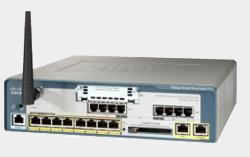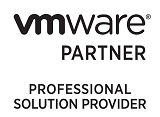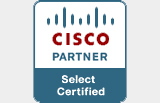 Product Overview
Product Overview
The Cisco® Unified Communications 540, part of the Cisco Unified Communications 500 Series for Small Business, is a critical part of the Cisco Smart Business Communications System. It is an affordable unified communications appliance that provides voice, data, voicemail, automated attendant, video, security, and wireless capabilities while integrating with existing desktop applications such as calendar, email, and customer relationship management (CRM) programs. This easy-to-manage platform supports up to 32 phones and voice mailboxes and provides flexible deployment options based on your needs, including support for a wide array of IP phones, public switched telephone network (PSTN) interfaces, and Internet connectivity.
Licensing
The Cisco UC 540 is available in two versions, an FXO (analog) model and a Basic Rate Interface (BRI) base model. The Cisco UC 540 includes 24 user licenses. These licenses enable the use of Cisco Unified IP Phones and allow users to access the IP PBX features, including voicemail. In addition, supplementary user licenses are bundled to help with deployments that need a few extra licenses. For additional licensing needs, the L-UC-PRO-8U= may be ordered. This increases the existing license count by eight, to reach a maximum of 32 user licenses.
Basic Call Center Capabilities
The Cisco UC 540 supports basic automatic call distribution (BACD) that can help answer outside calls with greetings and menus and allow callers to select the appropriate departments. BACD also provides managed call queues for calls that are waiting to be answered.
 Product Overview
Product Overview
The Cisco® Unified Communications 560 (Figure 1), a central part of the Cisco Smart Business Communications System, is an affordable unified communications appliance that provides voice and data communications, voicemail, automated attendant, video, security, and wireless capabilities while integrating with existing desktop applications such as calendar, email, and customer relationship management (CRM) programs. This easy-to-manage platform supports up to 138 phones and 125 voice mailboxes and provides flexible deployment options based on your needs, including support for a wide array of IP phones, public switched telephone network (PSTN) interfaces, and Internet connectivity. This reference guide describes the specifications and capabilities of the Cisco Unified Communications 560 (UC 560).
The Cisco UC 560 is available in two base versions: an FXO (analog) model and a Basic Rate Interface (BRI) base model. The FXO model is also available with a built-in T1/E1 interface. The Cisco UC 560 has built-in interfaces that offer fixed configurations, reducing complexity. In addition, this platform offers voice interface card (VIC) slots to support additional Cisco VIC modules.
Licensing
The Cisco UC 560 includes 24 user licenses. These licenses enable the use of Cisco IP phones and allow users to access the IP PBX features, including voicemail. In addition, supplementary user licenses are bundled to help with deployments that need a few extra licenses. For additional licensing needs, the L-UC-PRO-8U= may be ordered. This increases the existing license count by eight each; to a maximum of 128 user licenses. The UC 560 also has built-in licenses for unified communications features.
Basic Call Center Capabilities
The Cisco UC 560 supports basic automatic call distribution (B-ACD) that can help answer outside calls with greetings and menus and allow callers to select the appropriate departments. B-ACD also provides managed call queues for calls that are waiting to be answered.
Voice Resource Utilization
The Cisco UC 560 includes eight digital signal processors (DSPs) that enable digitized voice processing on the platform. The DSP resources available on the platform are used for various unified communications features, namely support of analog and digital VICs, prescheduled or ad hoc voice conference calls, and translation of digitized voice from a less complex codec (such as g711) to a more complex codec (such as g729) - typically used for deployments that use IP trunking (SIP or H.323) for PSTN access or multisite interconnection. Each DSP can support 16 g711 channels or 8 g729 channels. This enables a total of 128 g711 channels on the Cisco UC 560.
 Product Overview
Product Overview
 Product Overview
Product Overview



